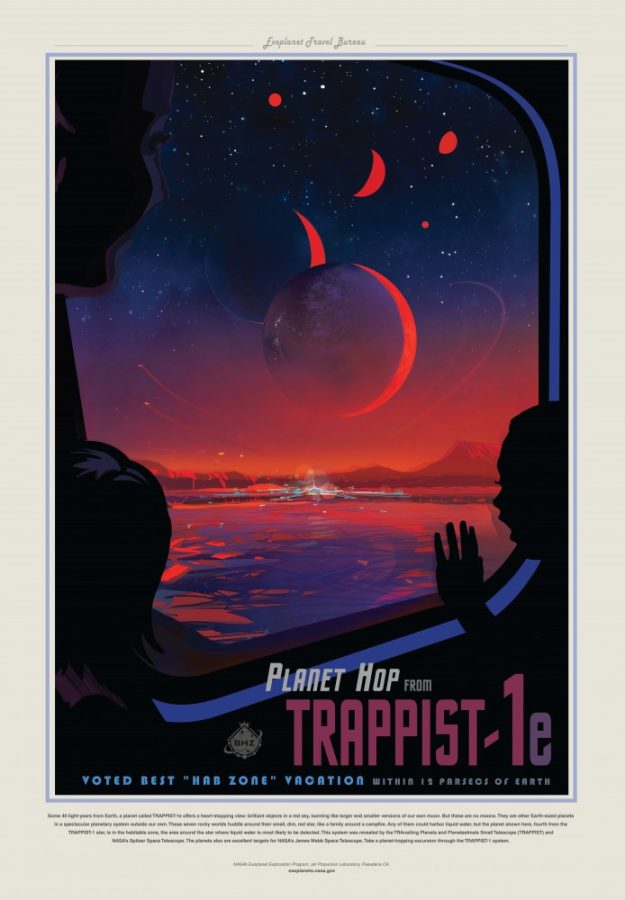In 2002, on the big island of Hawaii, two astronomers, using the Gemini North infrared telescope, gazed in the direction of the Aquarius constellation. The two men, UA professor of astronomy Laird M. Close and then-UA graduate student Nick Siegler, were looking for binary star systems—solar systems which orbit around two stars instead of one.
Their search brought them to one star in particular—at the time named 2MASS J23062928-0502285—which was a dim red dwarf star. What Close and Siegler couldn’t know at the time was that only a decade and a half later that dim, red star would become one of the most celebrated objects in modern astronomy. Close and Siegler were the first human beings to observe through a telescope at high angular resolution the star that would later be known as Trappist-1.

On Feb. 22, NASA held a press conference to announce the discovery of seven earth-sized exoplanets found in orbit around Trappist-1. Exoplanet is the title given to any planet that does not orbit around our sun.
This discovery marked the first time that scientists had found seven terrestrial exoplanets around a distant star. Three of these seven exoplanets are located within Trappist-1’s habitable zone. Also known as the “Goldilocks Zone,” it is the zone around a star within which a planetary surface can support liquid water. The habitable zone is the first place to look when trying to discover life in other solar systems.
RELATED: Solitary ice volcano on dwarf planet once one of many
Compared to our sun, Trappist-1 is small. If our sun was considered to be the size of a basketball, Trappist-1 is around the size of a golf ball. Because of its small size and the low amount of light it produces, Trappist-1’s habitable zone is much closer to the center of its solar system than that of our own sun.
The seven exoplanets orbiting Trappist-1 are so close to the star itself that they are all tidally locked to Trappist-1, as our moon is to the Earth. This means that the same side of all seven planets are always facing Trappist-1. Each of the exoplanets has a permanent light and dark side, which due to the extreme temperature differences present, does not bode well for the potential of life.
For NASA, the next step in studying these planets is to determine what elements comprise the atmosphere of each planet, particularly the three planets within the habitable zone. The way this is done is through using our space-based telescopes and a technique called transmission spectroscopy.
Transmission spectroscopy is used to gather details about the chemical composition of an atmosphere. As light from the host star passes through an exoplanet’s atmosphere, some of the light is absorbed by the atoms and molecules present in the atmosphere. By measuring this absorption, atmospheric scientists can determine the chemical compounds that make up the exoplanet’s atmosphere.
RELATED: Featured Science: Mirror lab builds cutting edge telescope parts
NASA is currently using the Hubble Space Telescope to determine if the newly discovered exoplanets’ atmospheres are primarily hydrogen or helium based. Steward Observatory postdoc Theodora Karalidi explained that “hydrogen and helium are primordial gases that are present in the beginning of a planet’s formation and can form a primordial atmosphere. In our solar system, we have no terrestrial planet that has such an atmosphere, but Kepler’s observations suggest that some potentially rocky exoplanets have trapped such a primordial atmosphere and have kept it until the time we observe them.”
Such a primordial atmosphere could be a strong indicator of potential life. “Models suggest that with various processes this atmosphere can start getting lost and a secondary atmosphere can start forming that resembles Earth’s atmosphere,” Karalidi said. By measuring if the exoplanet’s atmosphere is primarily hydrogen or helium, scientists will be able to determine if the exoplanet is in its early stages of atmospheric formation, or perhaps—if they’re lucky—if the atmosphere is conducive to sustaining life.
With the scheduled launch of the James Webb Space Telescope (JWST) in October 2018, NASA will have access to the most cutting-edge space telescope ever invented. With the ability to view longer wavelengths than Hubble, the JWST will allow scientists to perform more detailed transmission spectroscopy than is capable today and perhaps learn more about the Trappist-1 exoplanets and their atmospheres.
At just under 40 light years away, Trappist-1 will not be visited by humans in our lifetime. However, the scientific advancements that could be discovered through its study will be invaluable in paving the way for future generations, as well as answering the monumental question of whether we alone in the universe.
Follow Owen Zerambo on Twitter.









